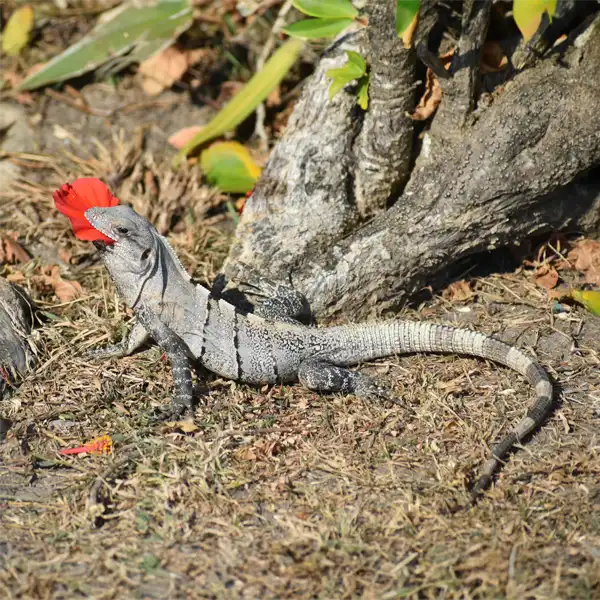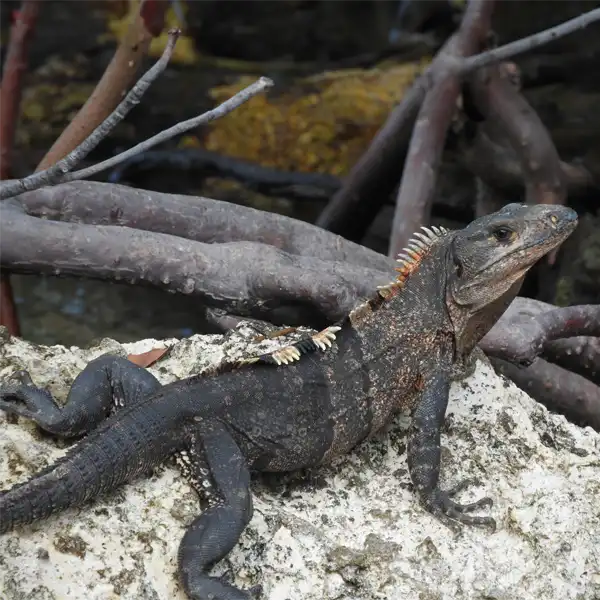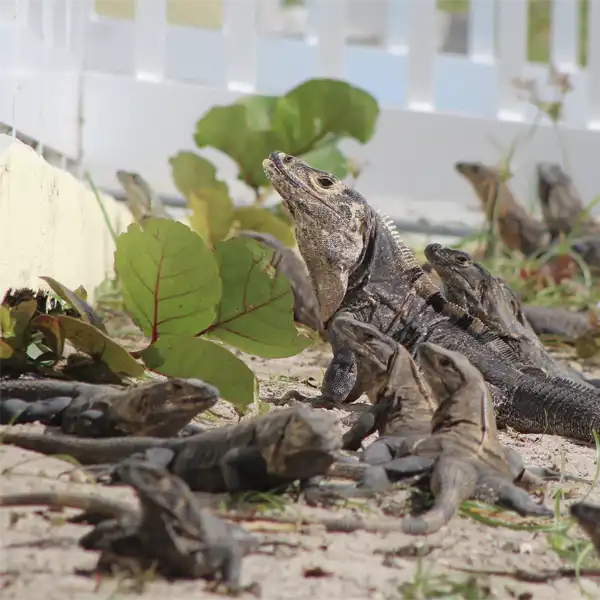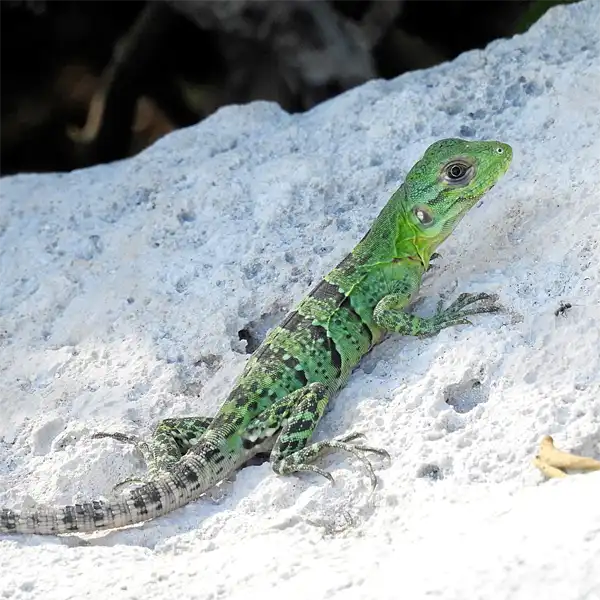Black Spiny-tailed Iguana
- Scientific Name
- Ctenosaura similis
- Also Known As
- Black Iguana, Common Spiny-tailed Iguana
- Range
- Central and Southern Florida
- Diet
- Flowers, Leaves, Stems, and Fruit
- Life Expectancy
- 19 Years
Quick Links
Black Spiny-tailed Iguanas in Central Florida
The black spiny-tailed iguana (Ctenosaura similis) is an invasive lizard that has established breeding populations in Central Florida. Often confused with the native green iguana (Iguana iguana), the black spiny-tailed iguana can be identified by its distinctive spikes, scales, coloration and habits.
This comprehensive guide provides detailed identification tips, biology facts, and prevention and control methods for black spiny-tailed iguanas in Central Florida. Read on to learn about black spiny-tailed iguana characteristics, reproduction, diet, impacts, signs of infestation, and professional removal options if you see these exotic lizards on your property.
Appearance and Identification
Black spiny-tailed iguanas can be distinguished from the similar-looking green iguana, especially at juvenile and adult stages
The green iguana lacks the distinctive spikes of the black spiny-tailed variety. The squat, heavy-bodied green iguana also has more orange coloration on the sides and underparts.
Maturation Rate
Young black spiny-tailed iguanas grow rapidly after hatching. They begin developing adult coloration around 8 months old as the spikes harden. At 1 to 1.5 years old, they reach sexual maturity and adult size. Rapid growth allows black spiny-tailed iguanas to reproduce early, fueling proliferation in warm Southern habitats.
Habits and Behavior
The black spiny-tailed iguana is diurnal, active during the daytime hours. They are expert climbers and prefer trees near water sources. Males stake out territory which may encompass female home ranges. They communicate using body signals and head bobs.
Black spiny-tailed iguanas dig burrows or occupy hollow logs, stumps, and crevices as retreats. These iguanas swim and dive well, escaping threats by going underwater. Their powerful tail is used as a weapon in defense. When threatened, they stiffen and extend the spiny scales to appear larger to predators.
Reproduction and Lifespan
Black spiny-tailed iguanas reach sexual maturity between 2 to 3 years of age. Mating takes place in fall or winter, with males courting multiple female partners. Females dig nests in burrows or soil, laying clutches of 16 to 30 eggs in early summer.
The eggs incubate for approximately 75 days before hatching in late summer. Black spiny-tailed iguanas may live up to 19 years in the wild. Their high reproduction rate allows populations to expand quickly with sufficient food and habitat available.
Ideal Habitat and Range
Central Florida’s subtropical climate is ideal for the black spiny-tailed iguana. Average temperatures range from the 60s to 70s°F (15 to 26°C) in winter and 80s to 90s°F (27 to 35°C) in summer. Annual rainfall averages 50+ inches, especially in Florida’s rainy season from May to October.
Abundant broadleaf trees, shrubs, and waterways provide food and habitat needed by these herbivorous, riparian lizards. Developments adjacent to natural areas allow black spiny-tailed iguanas to colonize backyards, parks, farms, and gardens in urbanized regions of Central Florida.
With high reproductive capacity and adaptability, black spiny-tailed iguanas proliferate rapidly in the subtropical Central Florida environment. Warm year-round temperatures, wet summers, and availability of diverse plants for forage create optimal conditions for these exotic reptiles to thrive.
Diet and Feeding
Black spiny-tailed iguanas are herbivores that browse on leaves, flowers, and fruits of many plant species:
- Trees: Ficus, palm, mahoe, sea grape, orchids
- Shrubs: Lantana, jasmine, bougainvillea
- Fruits: Mulberry, papaya, mango, figs
- Flowers and nectar sources
- Garden plants: Beans, lettuce, cabbage
They require daily access to fresh greens and water. Black spiny-tailed iguanas are prodigious foragers and spend much of daylight hours feeding. They are highly adaptable and utilize diverse food sources depending on availability.

Photo 15663939 © kmherpkid, CC BY-NC

Common Health Risks
While not innately aggressive, adult black spiny-tailed iguanas can inflict painful cuts and puncture wounds from bites and tail lashes when threatened:
- Bites may cause bacterial infection if severe.
- The stiff, sharp tail spines can impale skin and need medical removal if embedded.
- Allergic reaction may occur from proteins in the saliva among sensitive individuals.
- Salmonella bacteria may be present on the skin and feces.
- Property damage from burrowing and feeding activities.
Their large size and adaptability allows black spiny-tailed iguanas to outcompete threatened native wildlife like green iguanas and Florida burrowing owls for food and habitat. Removal is advised to protect people, pets, and native ecosystems.
Preventing Black Spiny-tailed Iguanas
The main control method is to exclude and remove black spiny-tailed iguanas from properties:
- Seal all potential entry points into homes using weather-resistant materials. Cover vents with wire mesh.
- Remove outdoor hides like debris piles, tile stacks, and dense shrubs near the home.
- Deter access to gardens with fences and remove fruit trees or fallen fruits from the property.
- Hire a professional wildlife removal expert to trap and relocate existing iguanas using humane methods.
- Discourage return by installing bird spikes or sheet metal on climbing surfaces.
Early detection and removal is key before iguanas become well-established. Once large populations exist, complete eradication becomes very difficult.
Black Spiny-tailed Iguanas in Central Florida – Conclusion
The black spiny-tailed iguana is an exotic reptile that thrives in Central Florida’s warm, humid environment. With high reproductive capacity and adaptability, these large herbivorous lizards can multiply into destructive populations when left unmanaged.
However, through exclusion, habitat modification, and professional trapping services, black spiny-tailed iguanas can be effectively controlled to reduce damage, injury risks, and impacts on native ecosystems. Any sightings of these spiky invaders on a property should be promptly addressed by a qualified wildlife expert. With vigilant prevention and early intervention, Central Florida residents can protect homes and nature from colonization by introduced black spiny-tailed iguanas.







